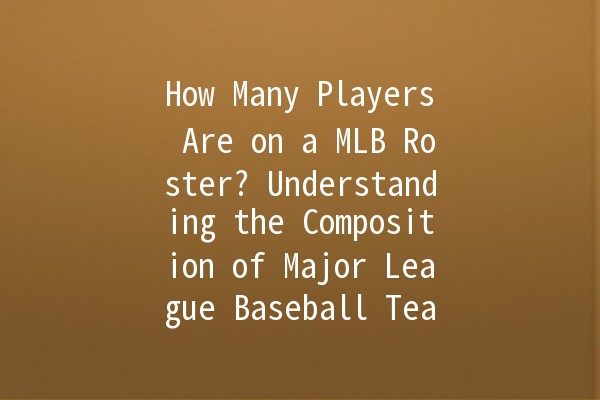When it comes to Major League Baseball (MLB), one of the fundamental questions that fans often ask is: how many players are on a MLB roster?
Understanding MLB Roster Limits
Official Player Limits
In MLB, a standard roster consists of 26 players during the regular season. This rule was put in place to allow teams the flexibility to adjust their lineups and game strategies effectively. Before the 2020 season, teams were allowed to carry 25 players, but the increase to 26 was made to accommodate the demands of a longer season and the challenges posed by player injuries.
It's crucial to differentiate between active rosters and total rosters. The active roster
Changes During the Season
MLB also permits certain activities that modify the roster throughout the year. For instance, teams may expand their rosters to 28 players
Roster Composition and Position Breakdowns
Understanding how many players are on a MLB roster is only part of the puzzle; knowing how those players are distributed across various positions adds depth to the discussion. An official MLB roster typically includes:

Pitchers: 1214 (including both starters and relievers)
Catchers:
Infielders: 6 (1st base, 2nd base, shortstop, 3rd base)
Outfielders: 35 (depending on team needs)
This breakdown can change based on a team's strategy, injuries, or game situation, thereby affecting how many players are retained at each position.
Tips for Understanding MLB Rosters Better
With a clearer understanding of the roster composition, fans and aspiring players can improve their engagement with the sport. Here are five productivityenhancing tips:
One way to stay updated on roster changes is by following team announcements. MLB teams often disclose changes in their rosters through official channels, including press releases and social media platforms. By staying tuned in to these updates, fans can understand the dynamics of the team better.
Example: If a star player is moved to the injured list, following team announcements helps fans pick up on how this will affect the overall roster and game dynamics.
Understanding player statistics is vital for fans who want to engage more deeply with the game. Familiarizing yourself with stats such as batting averages, earned run averages (ERA), and onbase percentages will allow you to appreciate roster decisions more thoroughly.
Example: If a relief pitcher is outperforming a starter, this might justify a shift in the roster that fans should recognize and discuss.
Joining online forums and communities focused on MLB can help fans cultivate a deeper knowledge of MLB rosters. Websites, such as FanGraphs or communitydriven platforms like Reddit, offer discussions on player projections and roster management strategies.
Example: Engaging with community discussions can illuminate perspectives that enhance your understanding of roster moves, such as trades or callups from the minors.
Spring training is an excellent time for fans to witness roster changes in realtime. Teams use this opportunity to evaluate upandcoming prospects and make decisions about who will fill the 26player roster at the start of the season.
Example:
Participating in fantasy sports leagues can help fans better understand player dynamics, including how different players fit into rosters based on their performance. Making these strategic decisions in fantasy football can translate to a broader understanding of the game itself.
Example: By analyzing players' performances weekly, you become adept at recognizing underappreciated players who may contribute significantly to their MLB teams.
Common Questions about MLB Rosters
How often can rosters change?
Rosters in MLB can change frequently, especially when teams make trades, call up players from minor leagues, or deal with injuries. Teams typically have a clear strategy for when to adjust their roster, with transactions being most common during the offseason and trade deadline.
Are there special rules for the postseason roster?
Yes, during the postseason, teams can adjust their rosters to fit the specific needs of the playoff format. Generally, this includes a roster of 26 active players, but teams may choose to alter their composition based on matchups and tactical considerations.
What happens when a player is injured?
When a player is injured, teams have the option to place them on the injured list (IL). This frees up a roster spot for another player. Depending on the severity of the injury, a player can be placed on either the 10day IL or the 60day IL.
Can teams have players on minor league contracts?
Yes, teams can have players on minor league contracts who are not part of the 40man roster. However, these players will need to be added to the 40man roster if they are called up to the Major Leagues.
What is the significance of the 40man roster?
The 40man roster is essential in managing talent within an organization. Players on this roster are eligible for the Major Leagues and provide teams with options if they need to fill a space in the active roster. It’s also crucial during the offseason when teams weigh player options and protective measures for their prospects.
Can players be sent back to the minors once they are on the active roster?
Yes, players can be optioned to the minors if they have options left on their MLB contract. Still, once they are called up from the minors, teams must make strategic decisions about moving them based on performance, team needs, and player development.
Roster Implications on Strategy and Future
Understanding the complexities of MLB rosters is critical for grasping how teams operate both on and off the field. The combination of active and inactive players allows flexibility in strategy, especially during highstakes games.
Furthermore, as teams plan for the future, they must continually assess the composition of their rosters, considering young talent and veterans. A robust roster enhances a team's ability to compete, adapt, and ultimately succeed—or not—throughout the season.
By expanding our understanding of how many players are on a MLB roster and how roster dynamics shift, both fans and players can contribute to and appreciate the game of baseball in new and exciting ways.